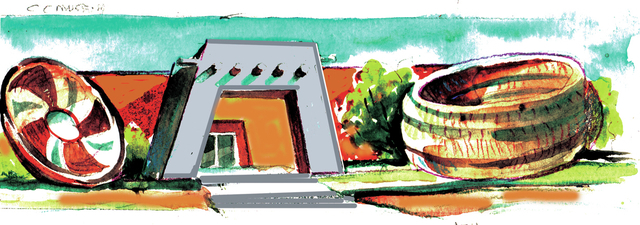Glimpse into past at Clark County Museum

The Clark County Museum offers absorbing excursions into Southern Nevada’s past. The 30-acre facility sits along Boulder Highway on the outskirts of Henderson. It includes indoor exhibit space, a neighborhood of vintage houses and other structures along a tree-lined street, a trail through a mining ghost town, a railroad depot and rolling stock, outdoor assembly areas and more.
It also provides one of the best family bargains in town. Admission to the Clark County Museum costs just $2 for adults and $1 for seniors and children. The museum is open from 9 a.m. to 4:30 p.m. daily, except Thanksgiving, Christmas and New Year’s Day.
Visitation has picked up considerably since the museum’s curator, Mark Hall-Patton, started making frequent appearances on the popular “Pawn Stars” TV series. However, it is an expansive facility and seldom seems crowded.
The basis for the museum was the private collection of Las Vegas pioneer Anna Roberts Parks, owner of Palm Mortuary. Over many years, Parks assembled an eclectic assortment of items that finally outgrew her 5-acre property. The collection went into storage but became a target of break-ins and vandalism. When Parks died in 1962, her daughter sought a safe place for her mother’s items.
Eventually, the Parks collection was donated to the Henderson Chamber of Commerce and housed in the Townsite School gymnasium on Water Street. It opened for public viewing in 1968 as the Southern Nevada Museum. Later acquired by the county, the collection anchored the growing assemblage of historical artifacts and buildings now known as the Clark County Museum.
A large Southwestern-style main building houses indoor exhibits, a small gift shop, restrooms, storage, work areas and offices. The journey begins with an introduction to the region during the Ice Age, complete with dire wolves and saber-toothed predators. You’ll meet the native people of prehistory, the hunters, gatherers, farmers and pueblo builders of yesteryear, and native groups who occupied Southern Nevada before the arrival of European settlers. Follow the explorers, fur trappers, map makers and soldiers who opened the area for traders, settlers, ranchers, prospecto rs and the building of railroads, highways and Hoover Dam. Learn about the growth of tourism, gambling, entertainment, the atomic age and more.
A special exhibit this spring showcases 100 regional Native American baskets from 1880 to 1930, assembled from the museum’s own holdings as well as private collections. “Tribal Treasures” will be on display until June 30.
Pleasant spring days enhance the experience of exploring the museum’s outdoor exhibits. A meandering trail takes visitors past a locomotive, the 1930s Boulder City train depot and several cars on the way to a re-created mining camp with weathered shacks and rusting equipment. An assemblage of restored houses and other buildings along a side street represents the early 20th century. Six residences moved from Las Vegas, Boulder City, Henderson and Goldfield join a vintage print shop, an early wedding chapel and a cabin and a trailer representing mobile America to form a neighborhood in the parklike setting. All the buildings are furnished with period decor and open to visitors on self-guided tours.
Margo Bartlett Pesek’s column appears on Sundays.